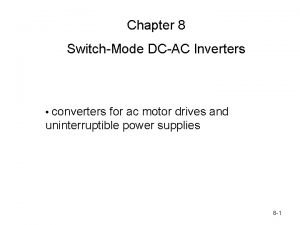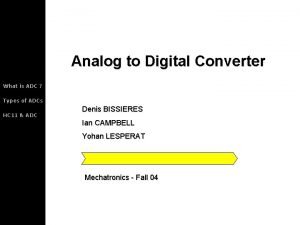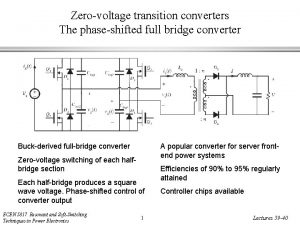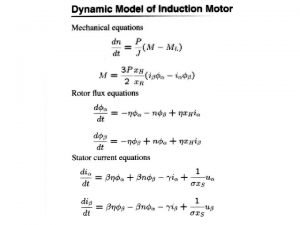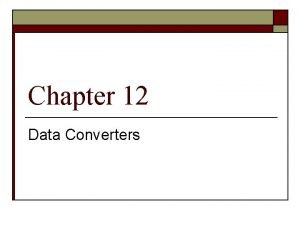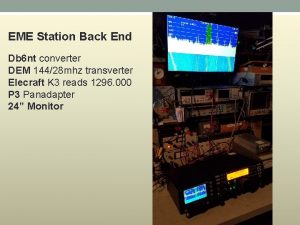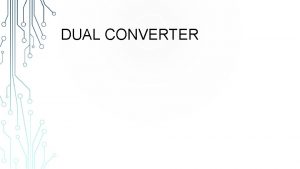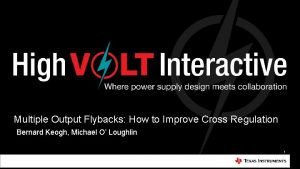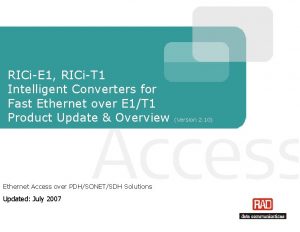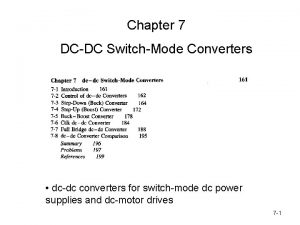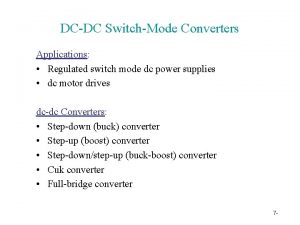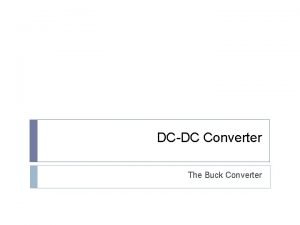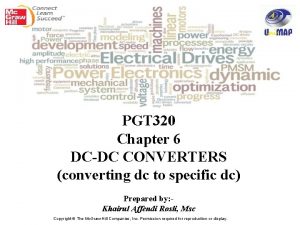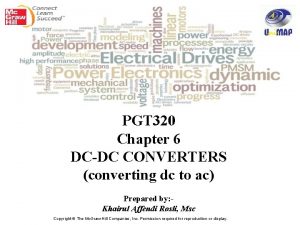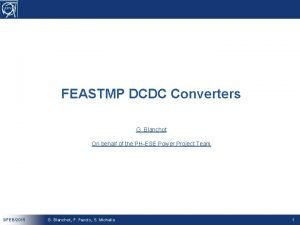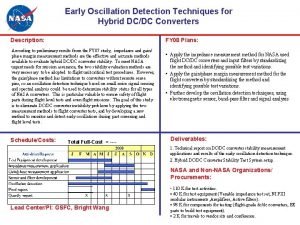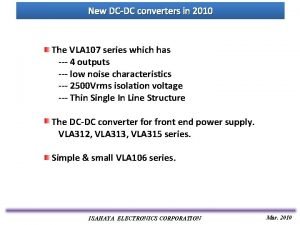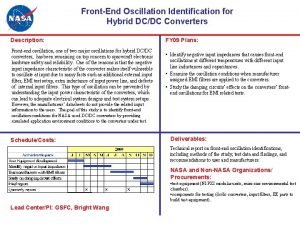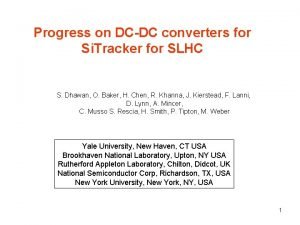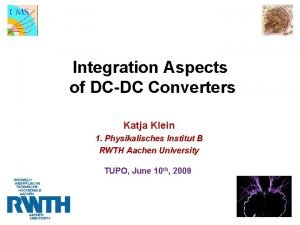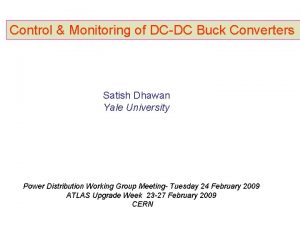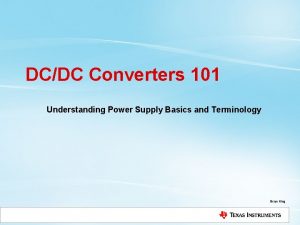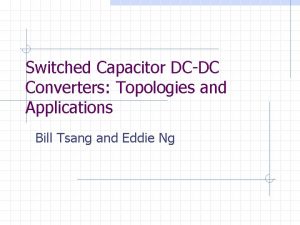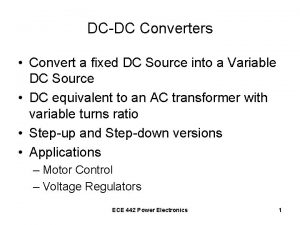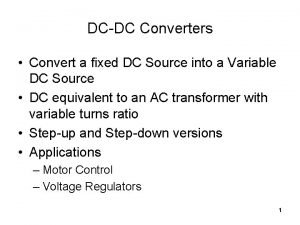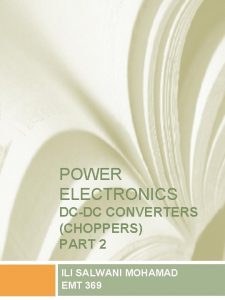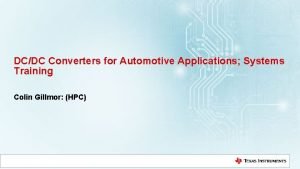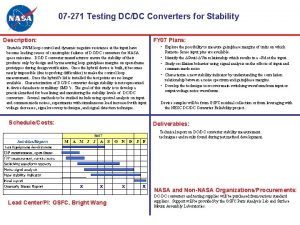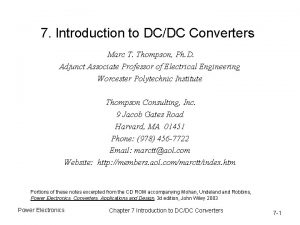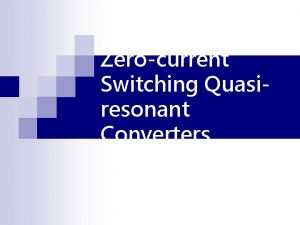Chapter 7 DCDC SwitchMode Converters dcdc converters for


























































- Slides: 58

Chapter 7 DC-DC Switch-Mode Converters • dc-dc converters for switch-mode dc power supplies and dc-motor drives • these dc-dc converters are studied: • step-down (buck) • step-up (boost) • step-up/ step-down (buck-boost) • Cúk • Full-bridge 7 -1

Block Diagram of DC-DC Converters 7 -2

Stepping Down a DC Voltage • switching at constant frequency: • pulse-width modulation (PWM) switching vo 7 -3

Pulse-Width Modulation (1) • signal-level control voltage vcontrol generated by amplifying the difference between actual output voltage and desired output voltage • switch control signal generated by comparing vcontrol with repetitive waveform 7 -4

Pulse-Width Modulation (2) • switch duty-cycle D is 7 -5

Step-Down (Buck) DC-DC Converter (1) 7 -6

Step-Down (Buck) DC-DC Converter (2) • average output voltage Vo 7 -7

R L C low-pass filter 7 -8

Continuous conduction mode (1) 7 -9

Continuous conduction mode (2) 7 -10

Continuous conduction mode (3) • input power equals output power: • step-down converter is equivalent to a dc transformer where the turns ratio is in the range 0 -1 7 -11

Edge of Cont. /Discont. Conduction • Critical current below which inductor current becomes discontinuous: 7 -12

Discontinuous Conduction Mode 7 -13

Discontinuous Conduction Mode (2) • Vo/Vd in the discontinuous mode • integrating the inductor voltage over one time period, • From the figure, 7 -14

Discontinuous Conduction Mode (3) 7 -15

Limits of Cont. /Discont. Conduction with constant D • The duty-ratio of 0. 5 has the highest value of the critical current • The boundary between the cont/discont mode is shown by the dashed curve 7 -16

Discont. Conduction mode with constant Vo • in regulated dc power supplies Vo is kept constant by adjusting the duty ratio D • since Vd=Vo/D the average inductor current at the edge of cont/discont mode is • when D=0 the maximum ILB, max is 7 -17

Discont. Conduction mode with constant Vo 7 -18

Step-Down Conv. : Output Voltage Ripple (1) Peak-peak voltage ripple: 7 -19

Step-Down Conv. : Output Voltage Ripple (2) Computing : During toff: 7 -20

Step-Down Conv. : Output Voltage Ripple (3) • ripple can be minimized by making fc of the low pass filter fc << fs 7 -21

Step-Up (Boost) DC-DC Converter • Output voltage is greater than the input • main application: regulated dc power supplies 7 -22

Step-Up DC-DC Converter Waveforms (1) 7 -23

Effect of Parasitics • The duty-ratio is generally limited before the parasitic effects become significant 7 -24

Step-Up DC-DC Converter Waveforms (2) • Assuming a lossless circuit Pd=Po Thus: • power remains the same • voltage increases • current decreases • equivalent to a DC transformer 7 -25

Edge of Cont. /Discont. Conduction (1) 7 -26

Edge of Cont. /Discont. Conduction (2) • recognizing that the inductor current IL and the input current Id are the same Id= IL • and • highest ILB at D=0. 5 • highest IOB at D=1/3 7 -27

Edge of Cont. /Discont. Conduction (3) 7 -28

Discont. Conduction (1) • Occurs at light loads 7 -29

Discont. Conduction (2) 7 -30

Discont. Conduction (3) 7 -31

Discont. Conduction (4) Solving Io in order to 1 Substituting above 7 -32

Edge of Cont. /Discont. Conduction with Vd constant 7 -33

Discont. Conduction with constant Vo (5) substituting Io. B, max We get 7 -34

Discont. Conduction with Vo constant (6) Solving for D 7 -35

Boost Converter Output Ripple (1) 7 -36

Boost Converter Output Ripple (2) • the ripple current flows through the capacitor and the average through R idiode Io (where =RC is the time const) 7 -37

Step-Down/Up (Buck-Boost) Converter • The output voltage can be higher or lower than the input voltage • The output voltage is negative 7 -38

Buck-Boost DC-DC Converter: Waveforms • equating the integral of inductor voltage over one period: • D>0. 5 means Vo>Vd • D<0. 5 means Vo<Vd • power is conserved Pd=Po: 7 -39

Limits of Cont. /Discont. Conduction (1) • The average inductor current is • Noting that average capacitor current is zero: re-arranging: Substituting: 7 -40

Limits of Cont. /Discont. Conduction (2) • Maximum values obtained when D=0 7 -41

Discontinuous Conduction Mode (1) • integrating the inductor voltage over one period • and since Pd=Po • This occurs at light loads 7 -42

Discontinuous Conduction Mode (2) 7 -43

Limits of Cont. /Discont. Conduction ; 7 -44

Limits of Cont. /Discont. Conduction with Vo constant 7 -45

Buck-Boost Converter: Effect of Parasitics • The duty-ratio is limited to avoid these parasitic effects from becoming significant 7 -46

Buck-Boost Converter: Output Voltage Ripple (where =RC is the time const) 7 -47

Cuk DC-DC Converter • The output voltage can be higher or lower than the input voltage • The output voltage is negative • Capacitor C 1 stores and transfers energy • in steady state average inductor voltages VL 1, VL 2 are zero • VC 1 is larger than Vd and Vo: 7 -48

Cuk DC-DC Converter: Waveforms (1) • when switch T is off • VL 1=Vd-VC 1 • VL 2=-Vo 7 -49

Cuk DC-DC Converter: Waveforms (2) • when switch T is on • VL 1=Vd • VL 2=VC 1 -Vo 7 -50

Cuk DC-DC Converter: Waveforms (3) • equating the integral voltages of L 1, L 2 over one period: • thus • and since Po=Pd 7 -51

Cuk DC-DC Converter: pros and cons Advantages • input current and output current have small ripple • Disadvantages • requirement of capacitor C 1 with large ripple current capability 7 -52

Full-Bridge DC-DC Converter • Four quadrant operation is possible • (TA+, TB-) (TA-, TB+) are switch pairs • bipolar voltage switching: switches in each pair are activated simultaneously • unipolar voltage switching: switches are activated independently 7 -53

Bipolar voltage switching thus ton of switch pair (TA+, TB-) is 7 -54

Bipolar voltage switching (2) • Duty-rate of pair (TA+, TB-) • Duty-rate of pair (TA-, TB+) • noting that • D 1 can vary between 0 and 1 • Vo can vary between -Vd and +Vd 7 -55

unipolar voltage switching • Duty-rate of switch TA+ • Duty-rate of switch TB+ • noting that • D 1 can vary between 0. 5 and 1 • Vo can vary between 0 and Vd 7 -56

Output Ripple in full-bridge DC converters • unipolar voltage switching vs bipolar voltage switching: • switching frequency is doubled • ripple is reduced ripple bipolar unipolar • better frequency response • better output voltage • more complex switch control 7 -57

Converter Comparison • Buck, Boost, Buck-Boost, Cuk transfer energy in only one direction • full-bridge is capable of bi-direccional power flow • in Buck, Boost, switch utilization is good • in Buck-Boost, Cuk, full-bridge switch utilization is poor CONCLUSION • Prefer Buck, Boost converters • If higher and lower voltages needed, use Buck-Boost, Cuk • If four-quadrant operation needed, use full-bridge 7 -58
 Dcdc detroit
Dcdc detroit Unipolar
Unipolar What is adc
What is adc Redox reaction in catalytic converters
Redox reaction in catalytic converters Dac konverter
Dac konverter Dcac converters
Dcac converters Digital to analog converters basic concepts
Digital to analog converters basic concepts Eme converter
Eme converter Single phase dual converter waveforms
Single phase dual converter waveforms Cross regulation definition
Cross regulation definition Intelligent converters
Intelligent converters Iso 22301 utbildning
Iso 22301 utbildning Typiska novell drag
Typiska novell drag Tack för att ni lyssnade bild
Tack för att ni lyssnade bild Returpilarna
Returpilarna Varför kallas perioden 1918-1939 för mellankrigstiden
Varför kallas perioden 1918-1939 för mellankrigstiden En lathund för arbete med kontinuitetshantering
En lathund för arbete med kontinuitetshantering Underlag för särskild löneskatt på pensionskostnader
Underlag för särskild löneskatt på pensionskostnader Tidbok
Tidbok A gastrica
A gastrica Densitet vatten
Densitet vatten Datorkunskap för nybörjare
Datorkunskap för nybörjare Stig kerman
Stig kerman Mall för debattartikel
Mall för debattartikel Magnetsjukhus
Magnetsjukhus Nyckelkompetenser för livslångt lärande
Nyckelkompetenser för livslångt lärande Påbyggnader för flakfordon
Påbyggnader för flakfordon Arkimedes princip formel
Arkimedes princip formel Publik sektor
Publik sektor I gullregnens månad
I gullregnens månad Presentera för publik crossboss
Presentera för publik crossboss Vad är ett minoritetsspråk
Vad är ett minoritetsspråk Kanaans land
Kanaans land Treserva lathund
Treserva lathund Fimbrietratt
Fimbrietratt Claes martinsson
Claes martinsson Cks
Cks Verifikationsplan
Verifikationsplan Mat för unga idrottare
Mat för unga idrottare Verktyg för automatisering av utbetalningar
Verktyg för automatisering av utbetalningar Rutin för avvikelsehantering
Rutin för avvikelsehantering Smärtskolan kunskap för livet
Smärtskolan kunskap för livet Ministerstyre för och nackdelar
Ministerstyre för och nackdelar Tack för att ni har lyssnat
Tack för att ni har lyssnat Referatmarkeringar
Referatmarkeringar Redogör för vad psykologi är
Redogör för vad psykologi är Stål för stötfångarsystem
Stål för stötfångarsystem Atmosfr
Atmosfr Borra hål för knoppar
Borra hål för knoppar Vilken grundregel finns det för tronföljden i sverige?
Vilken grundregel finns det för tronföljden i sverige? Varians formel
Varians formel Tack för att ni har lyssnat
Tack för att ni har lyssnat Steg för steg rita
Steg för steg rita Informationskartläggning
Informationskartläggning Tobinskatten för och nackdelar
Tobinskatten för och nackdelar Toppslätskivling effekt
Toppslätskivling effekt Mästar lärling modellen
Mästar lärling modellen Egg för emanuel
Egg för emanuel Elektronik för barn
Elektronik för barn

